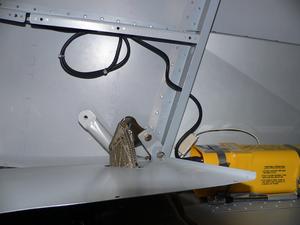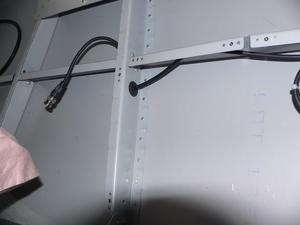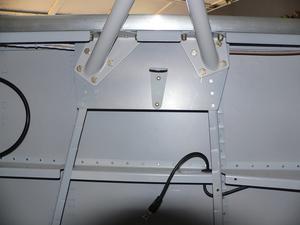I spent several days in Toronto (not work related) over the last two weeks. I've also spent some time running around to car dealers shopping for a new car. But I have managed to make some progress on the aircraft.
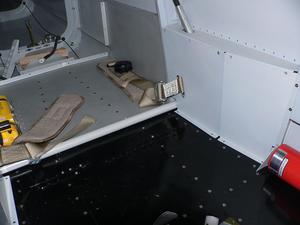 I painted the cockpit and aft baggage compartment floors and installed them. I didn't install the passenger footwells, as I will need to get under there to run the wires and antenna coax to the wings later. I also didn't install the aft part of the baggage compartment floor, as I will need to crawl back there to install the elevator pushrod later.
I painted the cockpit and aft baggage compartment floors and installed them. I didn't install the passenger footwells, as I will need to get under there to run the wires and antenna coax to the wings later. I also didn't install the aft part of the baggage compartment floor, as I will need to crawl back there to install the elevator pushrod later.
I modified the cockpit and aft baggage compartment floors to make them removable, so I would later be able to inspect the wiring, structure for corrosion, etc. I installed nutplates and used Micro Fasteners countersunk stainless steel fasteners with Torx heads. These fasteners aren't as strong as alloy steel fasteners, so they shouldn't be used in areas where a failure could cause a significant problem.
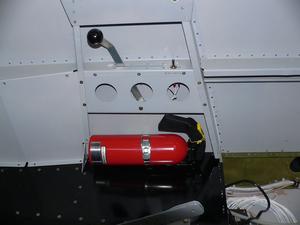 I installed the fire extinguisher mount on the left side of the cockpit. It tucks nicely in between two bulkheads, and can be reached from either seat.
I installed the fire extinguisher mount on the left side of the cockpit. It tucks nicely in between two bulkheads, and can be reached from either seat.
I finished the alternator wiring, vacuumed out the rear fuselage, torqued a bunch of fasteners, and finished securing the wiring for the engine preheater. I also replaced all the O-rings in the brake calipers, master cylinders and parking brake valve with ones made from Viton. The Viton seals have a higher temperature rating than the original Buna-N O-rings (400°F vs 250°F). Several RV owners have had the Buna-N caliper seals fail if the brakes get too hot. The brake fluid then pours over the hot brake disk and catches fire, as the normally used Mil-H-5606 brake fluid is very flammable, and has a flash point of about 250°F. Several RV owners have had brake fires. The Viton O-rings can be used with automotive brake fluids, which have the advantage of being non-flammable. There are some disadvantages to automotive brake fluids (some of them attack paint, and the ones that don't attack paint do not absorb water, so any water pools in the bottom of master cylinders or calipers, causing corrosion). I'm still trying to decide whether to use an automotive brake fluid, or the aviation MIL-H-83282 brake fluid. MIL-H-83282 is flammable, but it has a much higher flash point, so it is much less likely to be ignited. It also does not attack paint. Most of the joints in the brake system are in the cockpit, so there is a good chance of spilled fluid on the floor if there is ever a leak.
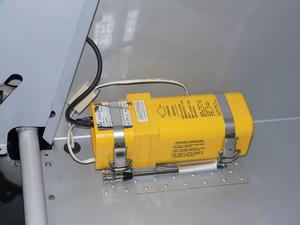 Today I finished running the ELT antenna cable from the ELT in the aft baggage compartment to the antenna which will be mounted on the right side of the cockpit, with the antenna sitting on the right side of the canopy. This should provide a much better antenna transmission pattern than the other commonly used locations of underneath the empennage fairing, or right up against the bulkhead behind the rear seat.
Today I finished running the ELT antenna cable from the ELT in the aft baggage compartment to the antenna which will be mounted on the right side of the cockpit, with the antenna sitting on the right side of the canopy. This should provide a much better antenna transmission pattern than the other commonly used locations of underneath the empennage fairing, or right up against the bulkhead behind the rear seat.
I also finished trimming the aluminum lower empennage fairings. Last weekend I managed to get the list of items to do before going to the airport down to less than one page long. Big celebration. Since then I've knocked several things off the list, and added a few more, but it is perhaps two items shorter. Progress :)
Saturday Steve Bushby, owner of Aerolite Flight Services, in Oxford Mills, ON hosted a gather of local RV builders and flyers. There was an excellent turnout, and a good time was had by all. Thanks Steve. Steve has a beautiful workshop, and he is busy building an RV-7 for someone (unlike the USA, builder assistance is now completely legal in Canada).
Steve is working full time in his shop, providing builder assistance, custom machine shop work, aircraft repair, etc. If you need assistance, or some machining, give Steve a call.
